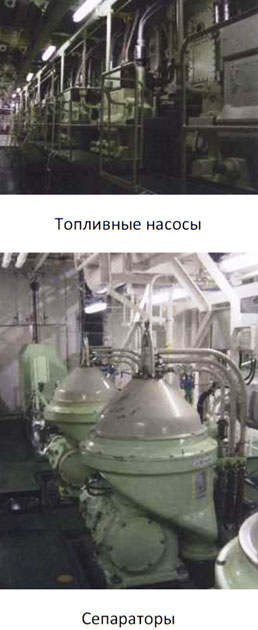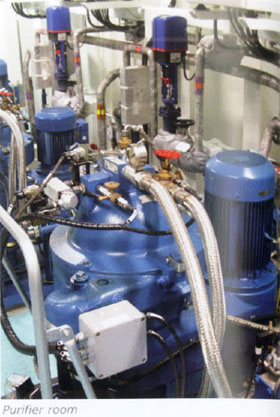Fuel for marine diesel engines
Fuel for marine diesel engines
The type of fuel a marine engine can use is the second most important characteristic, after power. There are two main types of fuel - diesel (MDO, Marine Diesel Oil) and heavy fuel (HFO, Heavy Fuel Oil). Let's talk about liquefied natural gas (LNG) separately.
 Heavy fuel oil has a much higher viscosity than diesel fuel at the same temperature. Forms carbon deposits and a lot of soot. The exhaust contains more sulfur than diesel. HFO requires heating up to 40 ° C even to pump it out of tanks and up to 120 ° C in order to inject it into engine cylinders - and these are additional complex systems that run on electricity, hot water or steam. The main advantage of heavy fuel, with all its disadvantages, is its low price, 30-40% cheaper than diesel fuel. In addition, it is heavier, which means that more fuel by weight will enter the tank.
Heavy fuel oil has a much higher viscosity than diesel fuel at the same temperature. Forms carbon deposits and a lot of soot. The exhaust contains more sulfur than diesel. HFO requires heating up to 40 ° C even to pump it out of tanks and up to 120 ° C in order to inject it into engine cylinders - and these are additional complex systems that run on electricity, hot water or steam. The main advantage of heavy fuel, with all its disadvantages, is its low price, 30-40% cheaper than diesel fuel. In addition, it is heavier, which means that more fuel by weight will enter the tank.
HFO can be used in medium speed and slow speed engines, high speed engines still require high quality diesel fuel.
Diesel fuel is much cleaner and only requires removal of possible contaminants, including water (separation), before being fed into the cylinders. Separators are special centrifuges in which denser water and dirt are separated from the fuel. Heavy fuels are also treated in separators, only at high temperatures.
Versatility
Heavy fuel engines are in fact versatile and run smoothly (and happily!) On diesel. What's more, they still have to run on light fuel in the waters of an environmentally friendly Europe during launch and during maneuvers.
If engineers and designers can teach high-speed marine engines to run on heavy fuel, it will be almost a revolution - it will be possible to save thousands and thousands of tons of metal and kilometers of track that the minders walk around changing around a low-speed engine the size of a multi-story building. With the same power, high-speed engines are several times smaller and lighter.
Fuel path
 Fuel for marine engines is stored on board in special reservoirs, tanks. Tanks are arranged so that the outer side of the vessel is never a tank wall; there must be two layers of metal. This protects the fuel from water ingress in the event of damage to the side, and, conversely, prevents fuel spillage in case of accidents.
Fuel for marine engines is stored on board in special reservoirs, tanks. Tanks are arranged so that the outer side of the vessel is never a tank wall; there must be two layers of metal. This protects the fuel from water ingress in the event of damage to the side, and, conversely, prevents fuel spillage in case of accidents.
The bunkering vessel pumps fuel directly into the tanks, while inveterate smokers must be patient - smoking on decks during bunkering is strictly prohibited. From the tanks, fuel is taken into a small tank in the engine room, from where it enters a tall and narrow sump tank, where water and dirt partially settle to the bottom. The settled fuel passes through the separator and accumulates in the clean fuel tank. Water and dirt from the separator are returned to the sump, from where they are periodically pumped out and disposed of.
Fuel pump and injectors
The classic diesel has a separate high pressure pump for each cylinder. They are supplied with fuel by a low pressure pump. The high pressure pump injects fuel into the cylinder through an injector that sprays it inside. In this case, the amount of fuel that has entered the cylinder is determined by the cross section of the injector nozzle, the pressure generated by the pump, and the time that this pressure operates. Excess fuel flows back into the tank.
A modern diesel engine has a Common Rail fuel supply system (in Russian - "battery"). In it, a single high-pressure pump (in common parlance, high-pressure fuel pump) pumps fuel into a large-volume common rail, a battery. From there, the fuel flows through electronically controlled hydraulic valves to the injectors and cylinders. The engine computer regulates the process. This allows very precise metering of fuel for each cylinder, and regardless of the angle of rotation of the crankshaft. This ensures high engine efficiency and helps to reduce the content of harmful substances in the exhaust.
Liquefied natural gas

Here we have not yet touched on the engines fueled by liquefied natural gas (LNG) and, accordingly, standing on gas carriers. This technology appeared and developed along with the gas carrier fleet. On gas carriers, liquefied gas is stored in low pressure tanks at a temperature of -163 ° C.
Gas is used as fuel not in pure form, but with the addition of 5-10% of conventional fuel, MDO or HFO. LNG-fueled two-stroke and four-stroke diesel engines use a different principle of ignition of the combustible mixture.
- In four-stroke engines this is a classic, Otto's principle - ignition from an external heat source (spark plug). The gas enters the cylinders at low pressure as part of the combustible mixture. Therefore, the engine power is slightly reduced compared to running on conventional fuel - less fuel enters the combustion chamber.
- Two-stroke engines still use the Diesel principle of pressure ignition. There are two ways:
- The first method - gas is injected into the cylinder in the form of a liquid at a pressure of 600 bar through a separate injector. But the problem is that pressurized gas does not ignite. Therefore, about 5% diesel fuel is injected additionally, this ensures the ignition of the mixture.
- The second way - gas is supplied to the combustion chamber at low pressure, compressed by a cylinder, and ignition is also provided by injection of conventional fuel at the right time.
The ratio of MDO (or HFO) to natural gas is controlled by a computer that controls engine power.
Natural gas is a very clean fuel and even when mixed with heavy fuel, the engine meets all emission control areas (ECA) regulations.
Outside the LNG fleet, the introduction of liquefied natural gas engines is constrained by the logistics difficulties of this fuel.
 +7 (812) 4-673-673
+7 (812) 4-673-673